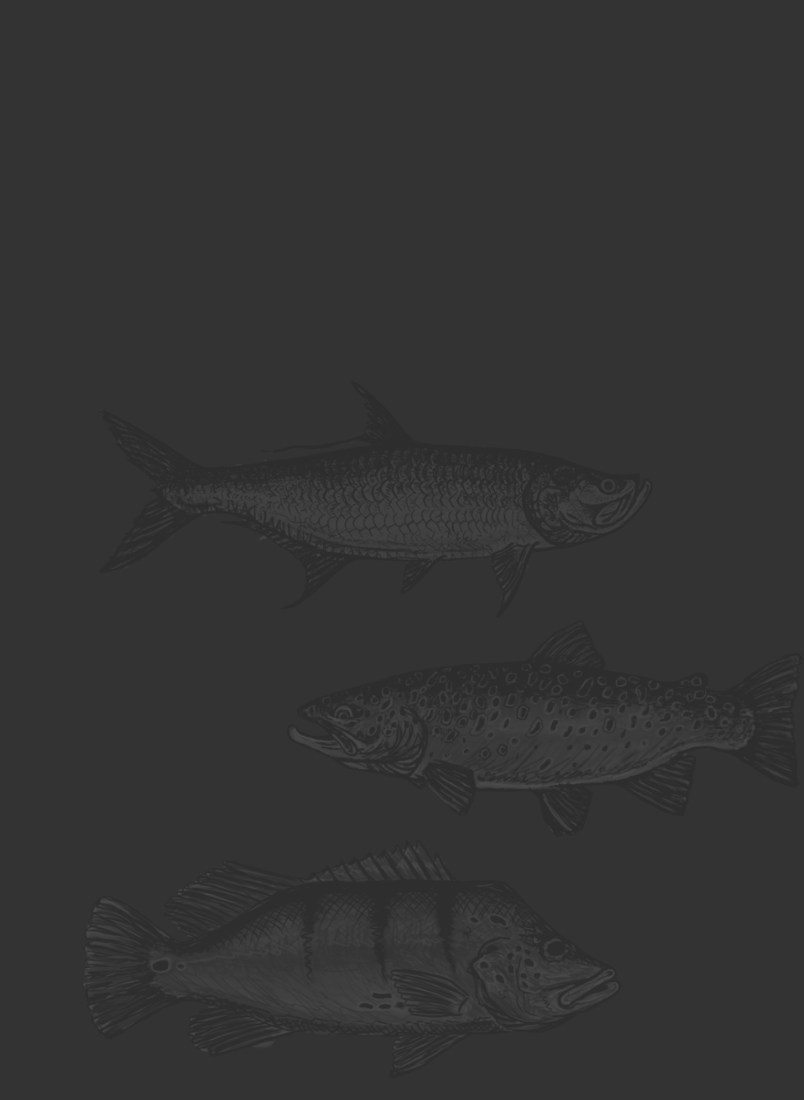Barracuda aren't always given the credit they deserve in the world of saltwater fly fishing. They are understandably maligned for attempting to snatch the bonefish on the end of your line, forcing responsible guides and anglers to find another flat without the "tax man" lurking nearby. But instead of finding them frustrating or a nuisance, consider them instead to be a challenging, aggressive predator that makes long runs, leaps wildly from the water, and slams a fly like few others can.
Habitat and Characteristics
Barracuda reach upwards of five feet in length and can weigh over 100 pounds, though its common to see much smaller fish on the flats. An average 'cuda is going to fall in the five to fifteen pound range, and anything pushing 20 or more is a really solid catch. They are common around reef systems, along wrecks, within channels running parallel to shallow water, and found cruising area shorelines or hunting for prey on wide open flats.
Barracuda are an ambush predator hoping to blend in or be forgotten about and are often found lying motionless, quietly observing their surroundings in hopes of catching an unsuspecting fish off guard. If they aren't lying still, they are slow cruisers who are hyper-aware of their surroundings, and for that reason, spookier than you might expect.
Side Note: The reality of fishing for bonefish and other game species in areas such as the Bahamas, Mexico, or Belize is that barracuda typically aren't far behind. Along with sharks, they are unlovingly referred to as the tax man because of their desire to get a peace of the pie, and barracuda regularly attack a bonefish mid-fight or targets one that is still in recovery and unable to escape. For this reason, its important to consider how to safely fish for and release game fish, and move locations if barracuda are present. Additionally, keep your hands out of the water as much as possible when releasing a fish if barracuda are present!

Tactics for Fly Fishing for Barracuda
When a barracuda prepares to attack, it's common to see them "line up," or ready themselves to charge. Once they have set their sights, barracuda bolt upwards of 35mph toward their prey in a show of 100%, blind commitment. Their large, protracted jaw lined with dagger-like teeth make quick work of fish flesh and bone. A predator's predator, barracuda are an opportunistic feeder and quick to react, hence why dive instructors tell divers and snorkelers to remove jewelry before entering the water as it can be mistaken for the shimmer of fish scales. That is not a mistake you want to make.
This is stating the obvious, but worth touching on: Don't let the fish know you're there. This is not the sort of game-changing advice you were looking for, but something that is important to consider. Barracuda are very keen observers, and despite their appearance, are quite wary. It's fairly common to see them right off the bow, but chances are very slim you can hook one of these fish as the jig is already up.
Now for the approach. Chances are good that you will be fishing for other game species when you spot a barracuda -- bonefish, permit, tarpon, snook, etc. To be ready, have your cuda rod out of the gunwale with the rod handle facing the bow. If you or your guide spot the fish, quickly reel in the line of your primary rod (or hand it to your boat partner) and pick up your cuda rod.
Now let's talk scenarios. The key with cuda fishing is to not put the fly right in front of them the way you might a permit or bonefish, as they will spook. Instead, you want to get their interest before drawing out their predatorial instincts, doing your best to imitate a fish fleeing for its life.
Cast approximately eight to ten feet ahead of the barracuda, just enough to get the 'cuda's attention without spooking them. Once the fly hits the water, you need to have tension on the line and start stripping. Some anglers prefer to start with a slower strip and gradually accelerate, while others simply start stripping like their life depends on it. There's no perfect answer, as every situation is different, but watch the fish's behavior and react accordingly. If you see the fish lining its torpedo-shaped body up for a charge, its time to start stripping it with some authority -- faster is not fast enough.

There are two lines of thought on how to strip, with one hand or two. With two hands, you can more fluidly accelerate the rate of your strip, in addition to being able to strip faster. Also, holding the rod in your arm and stripping the line with both hands will help prevent the dreaded trout set if you are prone to such behaviors. On the flip side, a single-handed strip will give you a better opportunity to pick up and recast should you need to. Like with all saltwater species, a quick change of direction is possible -- a bird's shadow crosses over, another prey enters the barracuda's view, or the barracuda spooks off from the sight of the boat. A lot can happen in mere seconds, so being able to quickly recast is helpful. The choice comes down to what you are most comfortable with.
The best piece of advice? KEEP STRIPPING AND DON'T DROP THE LINE. Fish fleeing for their lives don't pause to check their surroundings, so if you miss a beat and stop stripping the fly, there is a good chance the ante is up. One way to combat this is counter-intuitive to most sight fishing opportunities, but it does work if you have your guide's eyes to walk you through the motions. When the fly hits the water and you are about to start stripping, take your eyes off the barracuda and focus your attention on your stripping hand. You're far less likely to drop your line if you are fully focused on it. This takes a little bit of the fun out of it as you miss an apex predator charging down your fly at warp speed, but it can help should you need it.
Once the barracuda eats, keep your rod tip low and strip set a few hard times! In seconds, the barracuda will make a few explosive leaps and runs, before they quickly tire. It is not a long fight, but an exciting one. Once boat side, we recommend you letting your guide handle the fish, but if you are going to handle them, grab them by the tail first and support their body behind its gill plate, keeping your hands well away from their mouth. When it's time to get the fly, let your guide retrieve it or use pliers or a dehooking tool -- A single bite from a barracuda can cause severe harm.
Gear & Flies for Barracuda
Rod/Reel
You'll want a fly rod capable of casting a bulky fly at distance, so we recommend at least a 9-weight, though a 10-weight is commonly preferred. Most cuda flies are large streamer patterns, topwater poppers, or tube flies that are anything but aerodynamic, so you'll need some backbone to be able to efficiently cast them upwards of sixty or more feet. If you're hoping to target trophy-sized barracuda, you could even move up to an 11-weight.
The reel is important here, but not nearly as much as the rod. Most modern saltwater reels (that are properly cared for and lubricated) will be able to handle a couple hard runs from a barracuda. You don't need the same level of stopping power as a reel designed to fight species such as giant trevally or roosterfish, as barracuda are quite strong, but tire quickly.
Fly Line
A floating, weight-forward fly line with an aggressive taper is the way to go, as these lines are designed for making long casts into the wind and turning over larger flies.
Leader/Tippet
Your leader and tippet system for barracuda is pretty straightforward. Because you are going to be casting larger and/or more wind-resistant flies, you'll want a short, stiff butt section to assist in turning over the fly. You have several options, all of which can get the job done.
- First, use a roughly six-foot section of 40-50# hard nylon down to your tippet. You can tie a perfection loop on one end for a loop-to-loop connection with the fly line, or utilize a nail knot for a direct connection. On the other end, tie in your bite tippet with a standard blood knot.
- Secondly, in a pinch, simply use an old leader and snip off the thinner end to leave yourself with five or six feet of butt section. From there, you can tie in your tippet. This is a great method for targeting barracuda in a pinch, or if you want to extend the life of a pre-bought leader.
- Finally, there are multiple "toothy critter" leaders out there for a "plug and play" approach. These are usually 7.5 feet long in total, and pre-tied wire tippet or wire snap for attaching your fly. If you are someone who doesn't trust your knots or want to carry around spools of wire tippet and heavy leader material, this is the way to go.
To both hook and land a barracuda, you are going to need a roughly foot-long section of 30-45# wire tippet between your leader and your fly. Their teeth are razor-sharp and capable of slicing through a traditional fluoro or nylon shock tippet with ease. It is possible you can hook the fish right in the corner of their jaw and successfully land it without wire tippet, but you run the risk of unnecessarily losing the fish.
+ Saltwater Fly Fishing Leader & Tippet Guide

Flies
There are a lot of good options for barracuda flies, including large baitfish, poppers, and tube flies. Flies tied on high-quality, wide-gap hooks are recommended, and a size 2/0 is the sweet spot. Another important element to consider is that you are frequently required to make long casts when targeting barracuda, so the lighter the fly, the better.
For baitfish patterns, almost any traditional tarpon baitfish fly is going to work. Enrico Puglisi baitfish patterns are great because they are very light and easy to cast, while also maintaining a distinctive baitfish profile when wet. Other effective patterns include traditional deceivers, tarpon snakes, whistlers, or brush flies. Any color can work, but barracuda are reactionary fish, so brighter colors like chartreuse, white, red, and yellow are commonly employed.
Poppers are the most fun way to target barracuda. They can be a little more challenging to cast at distance and into the wind, so a 10-weight is recommended. Umpqua's traditional saltwater popper, N.Y.A.P. (Not Your Average Popper), pole dancers, and bangers are all solid options. Poppers will, without a doubt, grab a barracuda's attention as they chug through the surface film. If you can deliver them without spooking the fish, you're in for a real visual treat.
Finally, tube flies are very commonly employed as they imitate a fleeing needlefish, a delicacy no barracuda can turn up. These flies are tied with mylar tubing to imitate the flashy, long, and skinny profile of a needlefish. They often incorporate a stinger hook to maximize your chances of a hookup, as barracuda will often target the middle of a fish. These flies are fairly lightweight because the bulk of the body is hollow, but they are not always the easiest to cast into the wind due to their shape.

Next time you're preparing for a trip to a saltwater fly fishing destination, we hope you are better prepared for targeting barracuda on the fly. One of saltwater fly fishing's unsung heros, they are aggressive, powerful, abundant, and downright fun.





























